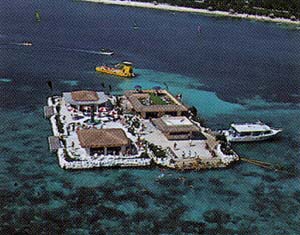
Your tour companies and guides are not receiving that money. Both taxes are imposed at a federal level. They are used to maintain the environment in which you are playing nicely. The 'port tax' is common throughout the world, so it isn't peculiar to Cancún. It levies funds from which the ports and beaches themselves can be maintained; as well as paying the people to staff them.
The 'reef tax' is more properly called 'The Federal Marine Park Tax' and can be viewed as your entrance fee into a marine national park. It was imposed after a study instigated, by the Mexican and the World Bank, into the effects of tourism on sea life in the area. In particular, the report was concerned with investigating the condition of the coral reef, which stretches parallel to the Yucatán Peninsula all the way down to Belize.
The report, published as 'The Economics of Managing a Marine Park in Cancún, Mexico', in 2001, was committed to 'attaining an equilibrium between enironmental damage to the coral reef and generating maximum social welfare.' In short, how could we have fun without killing the reef? Unfortunately, it found lots of cause for alarm.
Just consider how many boats and people are out in the strait between Cancún and Isla Mujeres at any one time. There are the speedboats on the Jungle Tours; fishing trawlers in the sea; the party catamarans and passenger ferries; the yachts of the rich and famous; the Caribbean cruises; the snorkelers and the divers; not to mention the navy and the emergency services. The report estimated that, in 1997, approximately 1549 visitors every single day crossed the Punta Nizuc section of the coral reef area. As a result that reef was already showing signs of wear and tear. It highlighted five causes of this:
1, Human contact - visitors diving down to break off pieces of coral to take home as souvenirs;
2, Boat collisions with the reef formations;
3, Hydrocarbon pollution - oil and gasoline leaking from boats;
4, Sunscreen pollution - coral viruses caused by swimmers not using biogradable sunscreen with non-contamining ingredients;
5, Sewage - human waste being discharged into the water, particularly in the Nichupte Lagoon.
The result was that the level of hydrocarbons in the water was ten times higher than that recommended by UNESCO; nutrient levels were too high; and the diversity and populations of marine species in the region had sharply declined.
Something clearly had to be done. What followed was legislation. Article 198 of the Mexican Federal Law states that 'visitors who practice aquatic activities within the National Marine Park' have to pay a tax of US$2. This money is used exclusively for protecting the waters and the coral reef areas. There are many and varied ways that this money is spent. These include:
* The building of an artificial island for the mooring of speedboats over the Punta Nizuc coral reef. There are only a few mooring spots, hence that limits the number of people over it at any one time. It also stops boats colliding with the reef or damaging it with their anchors.

* Staff to monitor the water levels and the condition of the coral reef. Plus staff to inspect all tour operators to ensure that they are complying within the new rules and recommendations.
* The construction of bigger sewage processing plants, better able to cope with the sheer number of tourists.
* All repair work and preventative work, as necessary.
Other measures which came into force included:
* The banning of non-biogradable sunscreen in the Caribbean Sea. Visitors intending to head out on aquatic activities are likely to be checked and all non-biogradable sunscreens taken off them. All tour operators are required to sell biogradable sunscreen, with non-contaminating ingredients, as substitutes.
* A licence required for all boats in the Caribbean Sea. Though there is only a nominal fee for this licence, it can only be gained if the captain/guide has undertaken a two day course in reef ecology and care.
* Restrictions upon the type of oil and petroleum that boats are allowed to use.
* All visitors to the Punta Nizuc coral reef are required to wear lifevests. In addition to being lifesavers, these vests have the added bonus of being buoyant. Those wearing them will find it difficult to dive underwater to break off pieces of coral for souvenirs.
In short, the recommendations and your payment of the reef tax is ensuring that there will still be such beauty, in the lagoons and the sea, for many generations to come.


No comments:
Post a Comment